The Economics of Black Cohosh
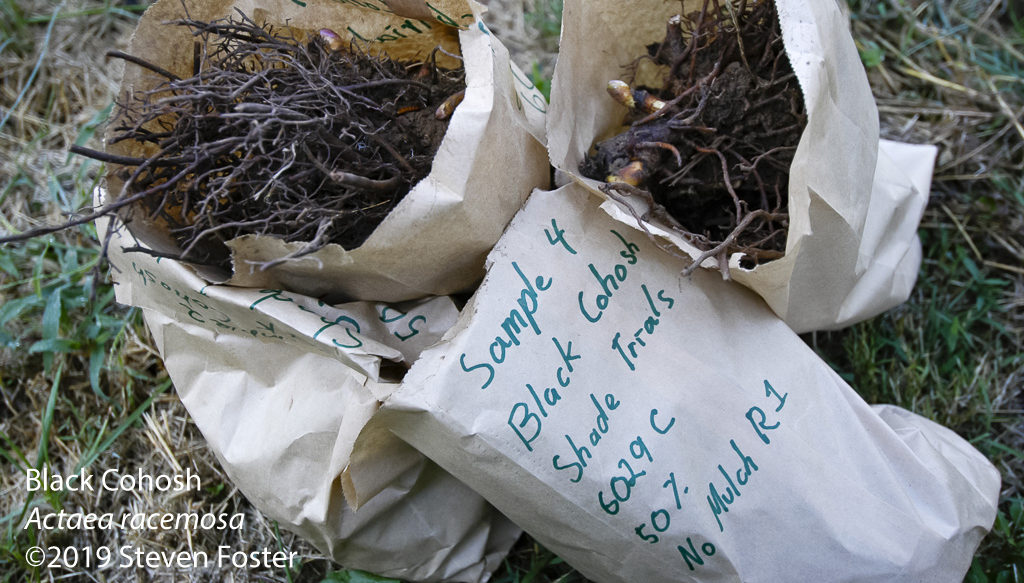
by Ann Armbrecht
This is part 2 of a 2 part series. Begin here for part 1. See Steven Foster’s saw palmetto series as well.
How Much is it Worth?
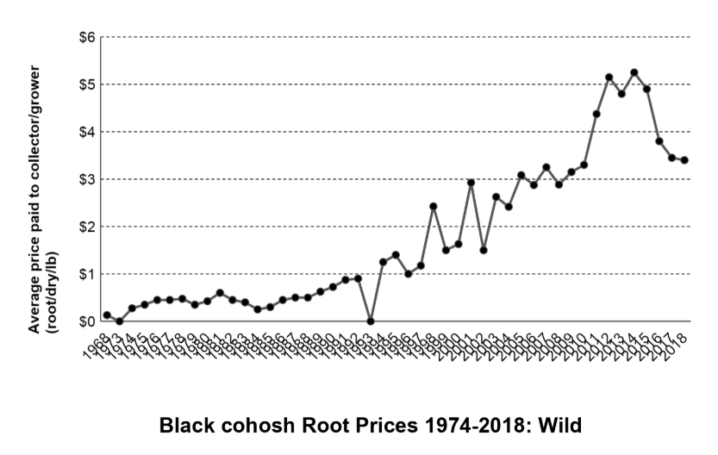
Eric Burkhart plotted these prices from a personal database compiled over the years for forest botanicals. In most years, the average is calculated from at least 4 buyer price sources.
1936, the price range for dried black cohosh roots was between 2 and 3 cents per pound. Fifty years later, buyers offered 80 cents per pound for dried roots, $2.00/pound for cut and sifted and retail prices beginning at $2.90/per pound. By 2003, the price was $3.00 per pound.[1]
Because black cohosh has a lower market value than goldenseal and American ginseng, buyers need to trade more. A digger needs to harvest 50-60 pounds to make it worthwhile, Eric Burkhart, a botanist at Penn State University involved with developing sustainable forest-based stewardship for Appalachian forest products, told me. “You can dig a lot of roots if you are active in the woods, about one root a minute,” he said. Post-harvest handling takes longer, about 10 minutes per root to wash and chunk it into smaller pieces. They found that if harvesters could get $50 as a base price for dried material, it was attractive for people to harvest.
“But $50 is $45 more per pound than anyone wants to pay.”
“These plants aren’t dandelions,” Eric said. “Forest botanicals take time and patience to manage and grow and harvest. They are precious medicines. We need to treat them with respect. Part of that means paying a price that recognizes their value. If you are not paying people reasonable wages to manage the plants responsibly, there will always be haphazard collectors. People will come and go depending on whether they need money or not.”
“There are major issues with quality and sustainability,” he continued. “It’s a difficult issue to solve. But it depends in part on investing in and empowering the people living in these areas and harvesting the plants, providing education and resources for post-harvest handling.”[2]
Of the companies I looked at online, two seemed to be considering these broader questions in how they marketed their black cohosh products to the public. But even then, I mostly trusted their claims because I knew the people responsible for sourcing and the questions they were asking. Had I not known these people I would have been more skeptical.
It’s Called Wildcrafting for a Reason
If the industry is not able to find a way to invest in the value networks of wild harvested plants like black cohosh, Eric sees it going the way of ginseng and goldenseal, paying farmers to grow plants under artificial shade. “It will be unfortunate that the plants can’t be grown in Appalachia because companies aren’t willing to pay a fair price to buy the botanicals from where the plants grow well.”
Ed Fletcher of Native Botanicals, an experienced trader and consultant on North American medicinal plants, said that the price per pound of black cohosh is way too cheap. He tells all his customers that when the price increases, it can trickle down to wildcrafters. If it doesn’t, they won’t be there next year. “Every year we lose a generation of wildcrafters,” he said.
“Black cohosh isn’t a high-dollar item like ginseng,” Ed said. “It is harvested by people who know what they are doing, not those just trying to make a buck. The knowledge is passed through the generations and it tends to be harvested in a more sustainable way because people want to make sure the plants will be there when they come back next year.” But, he said, echoing everyone else working with collectors, “we need to make it worth their while and pay them better.”
Ed paused. We were speaking on the phone. “It’s called wild crafting for a reason,” he said. “It is a craft. You have to know how to find it, dig it, get it in the future. If we don’t continue to increase their benefits, they aren’t going to be there.”
I asked Ed what needs to change.
“We need to educate consumers, as a way to educate buyers to be willing to pay the extra price.” We need to make it clear that in paying a little more for a product, you are contributing to this cause of helping to produce a sustainable product. “Let people know this is a craft. It isn’t just something anyone can do.”
Pricing
Eric Burkhart cautioned that any price increases for black cohosh must be done carefully. While it is important to push so that wildcrafters or forest farmers receive a decent price in the end, Eric said, “we also don’t want the prices to just jump up across the board as this will send everyone into the woods to dig cohosh. And then we would have another ginseng or goldenseal situation on our hands.”
The challenge, Eric explained, is how to increase prices to conscientious wildcraft stewards and forest farmers, without pressuring for price increases across the industry in a way that encourages short term financial gain over stewardship. The Forest Grown Verified program (see below) is one effort to accomplish this.
For an excellent introduction to the concept of forest cultivation of Appalachian plants, see “Transitioning from wild collection to forest collection of indigenous medicinal forest plants in eastern North America is constrained by lack of profitability,” by Eric Burkhart and Michael Jacobson. For background information leading up to the Forest Grown program and related articles, see UpS Helps Kick off Forest Grown Program.
Adulteration
The price of black cohosh is not only so low because wild harvested plants are traditionally undervalued. Black cohosh is widely known to be adulterated with related species of Actaea (syn. Cimicifuga) from China.[3] Steven Foster provides a thorough discussion of both the nomenclature confusion between these various species as well as the evidence of substitution, intentional or not, among these species. Between 300,000-380,000 lbs. of wild-harvested, dried whole black cohosh root from the US were estimated to enter the wholesale trade in 2011 at prices from $4.50-7.50. Chinese sources, in turn, sell powdered material or extract to the US market.
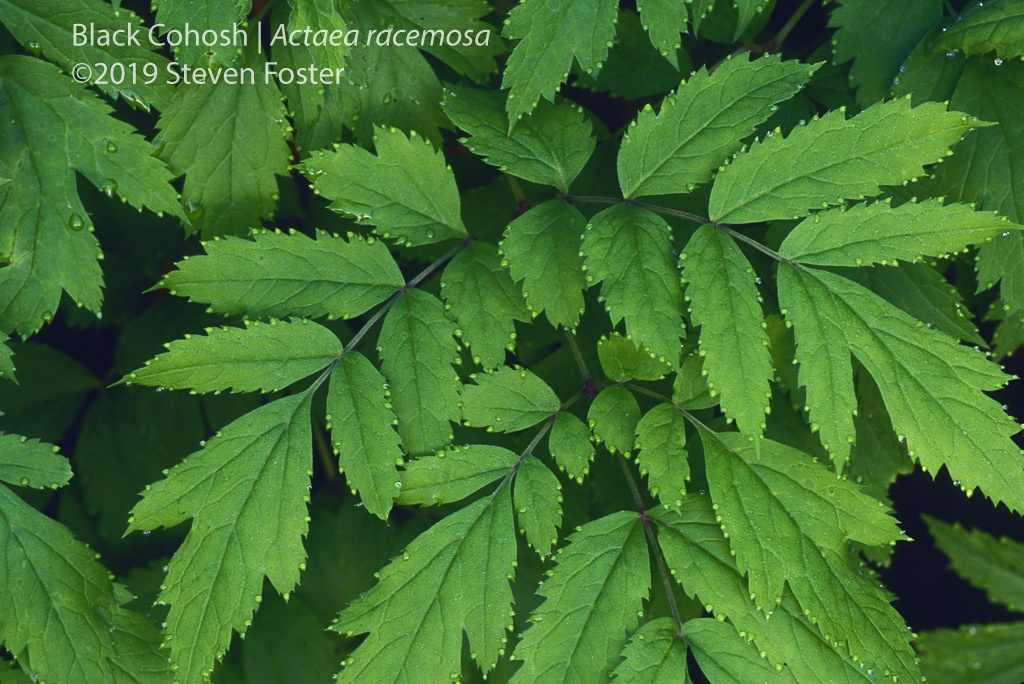
Black cohosh leaf detail. Photo by Steven Foster.
The prices vary based on quality, form, and quantities purchased, but, as Foster writes, “the overall trend shows an economic adulteration incentive with the price of Chinese material running at about 25-30 percent, or in some cases, much less, of that of authenticated black cohosh in wholesale trade.”[3]. Foster also discusses incidences of possible liver toxicity associated with black cohosh that may have been due to using one or more Chinese Actaea species rather than genuine black cohosh [3]. It is difficult to determine with any accuracy how much of the trade may be adulterated Chinese Actaea species, but to avoid the risk, buyers should work closely with qualified analytical labs to authenticate black cohosh extracts.
For more information, see the Botanical Adulterants Prevention Program lab guidance document on black cohosh and the Black Cohosh Adulterants Bulletin.
Forest Grown
Beginning in 2017, Mountain Rose began a pilot project with small forest farmers represented by Appalachian Sustainable Development to source forest grown black cohosh. They now offer two types of cut and sifted black cohosh: certified organic which sells for $22.50/lb. and certified Forest Grown and certified organic which sells for $40.25 for an 8-ounce bag. Most of their woodland botanicals are not offered for wholesale, rather in retail sizes of 1, 4, and 8-ounce bags.
Jennifer Gerrity, Chief Operations Officer of Mountain Rose, said that in some cases they also cap how much wild plants they will buy. Once they run out, they don’t buy more for that harvest cycle.
Even though the price is significantly higher, they are sourcing certified Forest Grown black cohosh because they want to encourage more cultivation of black cohosh in its native habitat and because, as Jennifer told me, they want to create more options for sourcing these roots. “We don’t want to be contributing to their depletion.” Each year Mountain Rose sells a bit more Forest Grown and the trends have been increasing. “Sustainability is important to us and to our customers,” Jennifer said. “Our customers are knowledgeable and willing to pay more. They want to be part of the solution and part of a paradigm shift to reduce the volumes of wild harvested at-risk plant and see more cultivated, wild stewarded material available for commerce.
On March 15, 2019, Pennsylvania Certified Organic (PCO) transferred the PCO Forest Grown Verification Program to United Plant Savers (UpS). Visit United Plant Savers for more information on the program and next steps.
Wild-Harvested Black Cohosh
Woodland Botanicals are only a small part of Mountain Rose’s product line – and Mountain Rose’s purchases are a drop in the bucket of the trade of these plants and so while the Forest Botanicals program offers one solution, it isn’t the only solution. Wild harvesting in Appalachia has typically provided a source of income for those without that access.
The FairWild standard is a voluntary sustainability standard designed for wild-collection of medicinal and aromatic plants that recognizes the importance of wild harvesting as a source of income. No species are FairWild certified in the US, but the standard can provide a guide for assessing the sustainability of wild harvested plants. Below are key points from the standard that can be useful in asking companies about where and how they source plants from the wild.
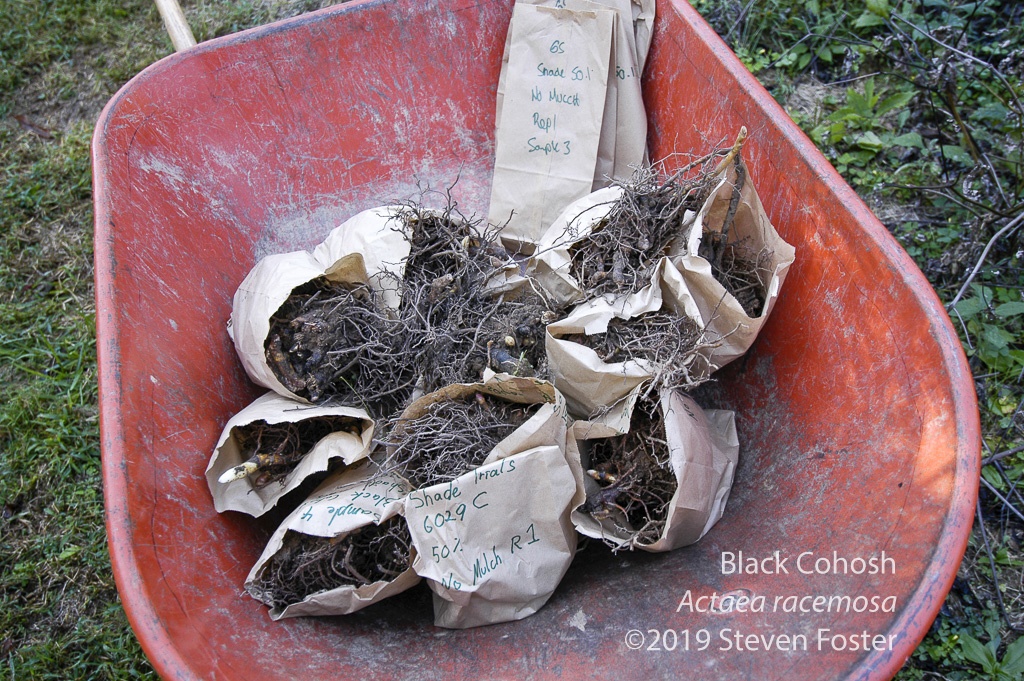
Black cohosh freshly harvested root samples for analysis. Photo by Steven Foster.
The FW indicators are much more thorough and explain these points in great detail. The FairWild Performance Indicators include a table (page 4) that clearly and thoroughly outlines the various factors influencing the risks of unsustainable wild collection.
Every species responds differently to the pressures of wild harvesting, which means that the questions must be asked for each species.
- What is the risk of over-harvesting black cohosh? What is the conservation status of the species? Is it known? How is it being monitored?
- Are collection and management practices based on adequate identification, mapping and overall documentation?
- Is the rate of harvesting within the ability of the species to regenerate over the long term? This information is not available on a regional scale for roots harvested from Appalachia. Can a particular buyer document that this is the case for the roots they purchase?
- How is a company ensuring that the black cohosh they have purchased has been sustainably harvested?
What Can I Do?
The companies I contacted didn’t seem used to being asked questions about where they sourced their black cohosh. The first thing that anyone buying herbs from someone who didn’t grow or harvest them themselves is pick up the phone and ask where the herbs are from. If companies know their customers care about where raw material is sourced and how it is handled, they are likely to pay more attention.
References Cited
- Predny, M.L., De Angelis, P., & Chamberlain, J.L. Black cohosh Actaea racemosa. An annotated bibliography. Asheville, NC: Southern Research Station, 2006:10. For a complete list of references on black cohosh, see part 1 of this series.
- Eric Burkhart discusses his research into the trade of Appalachian natives species in the free webinar, Forest Botanicals Deep and Tangled Roots. Feb 2015. For an overview of black cohosh in commerce, including guidance on harvesting and processing, see Davis, Jeaninie . Black Cohosh: Actaea racemosa L. Mountain Horticultural Crops Research and Extension Center: 2013 (revision of articles written by Jackie Greenfield, Jeanine Davis, and Kari Brayman).
- Foster, S. Exploring the Peripatetic Maze of Black Cohosh Adulteration. HerbalGram 2014:82:32, p. 24, p. 45.

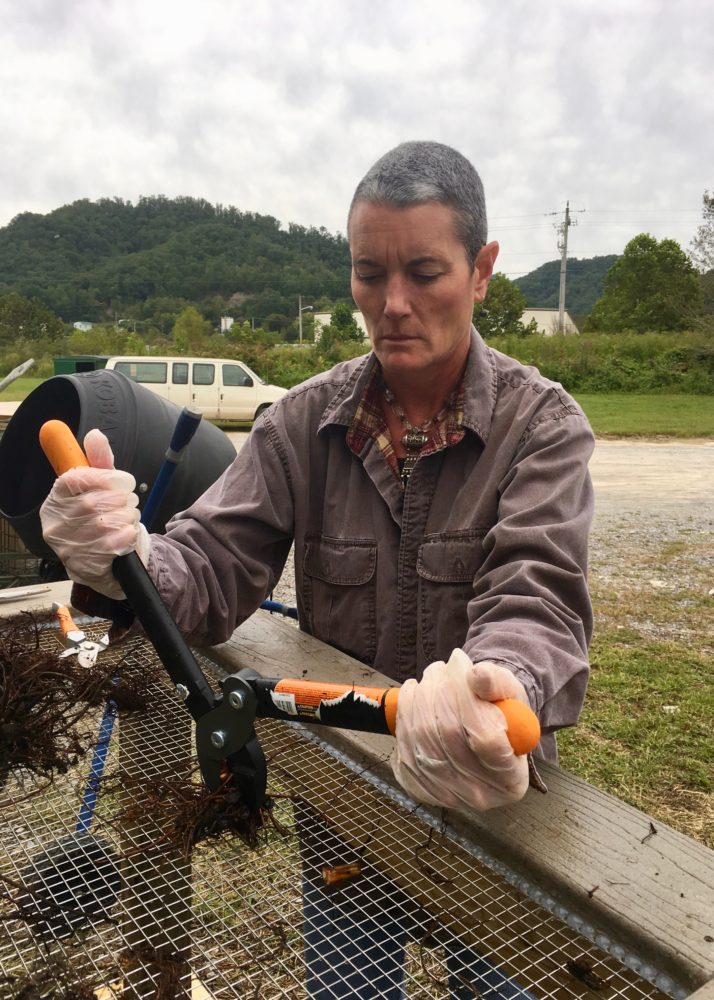
When do you harvest black cohosh. Right now the plants are 2 ft tall and there are thousands of them growing in the woods on a golf course I work at
In the fall, after the plant has died back and the energy gone into the roots. Make sure if you are close to a golf course that there aren’t pesticides being used, getting into the soil near the plants. And only harvest small amounts! There are great examples of good wild harvesting practices out there. Good luck!
I have a lot of the root ,It’s hard work I can’t get rid of it for less than $8.00/ Lb. Is there better prices cause it’s hardly worth it at that?
I’ve got ten years experience digging black cohosh and I really enjoyed the article
I have 400 lb trying to find a buyer